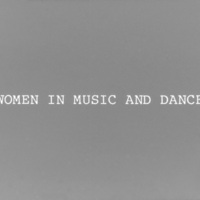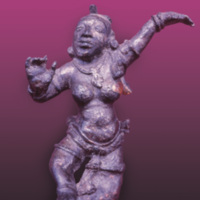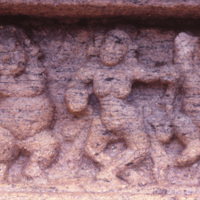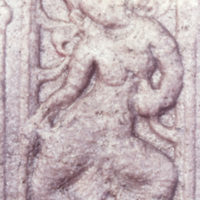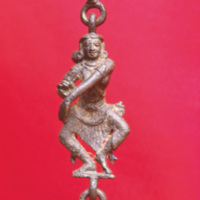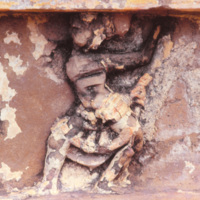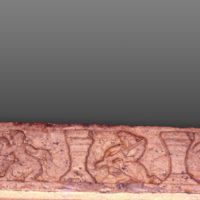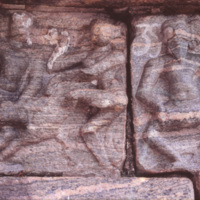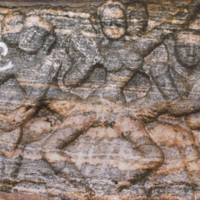Main Menu
AORC Libraries
Browse Items in Women in music and dance (21 total)
Women in music and dance
Description: Women in music and dance: Music and dancing were considered special accomplishments of women. Appearing as they do in temple sculpture and painting, it is mostly the devotional aspect of these art forms that is represented. However, one does also notice the purely decorative use of the female dancer in art. The expression of bhakti or devotion through music and dance is common to both Buddhist and Hindu forms of worship. Their incidence is more pronounced in the Polonnaruva and post-Polonnaruva periods.
Contributor: Co-Author: Seneviratna, Harsha
Collection: Women in Sri Lankan Sculpture and Painting
Tags: AISLS, ICES, PDWESLSP, Women in music and dance
A bronze statuette of a dancing girl
Description: This bronze figure of a female dancer was found at the Kuttampokuna or Twin ponds of the Abhayagiri monastery at Anuradhapura, Sri Lanka. Some authorities believe that it was a part of a chain suspending an oil lamp. It is important to note that female dancers were considered appropriate as decorative devices in buildings associated with monasteries during the mid-Anuradhapura period to which this bronze may be assigned.
Contributor: Co-Author: Seneviratna, Harsha
Collection: Women in Sri Lankan Sculpture and Painting
Tags: AISLS, ICES, PDWESLSP, Women in music and dance
Female dancer between two male musicians
Description: This stone relief carving of a female dancer between two male musicians can be seen on the north face of the Lion Bath at Mihintale. This pond was attached to a monastic complex, and can be assigned to the mid-Anuradhapura period according to scholars.
Contributor: Co-Author: Seneviratna, Harsha
Collection: Women in Sri Lankan Sculpture and Painting
Tags: AISLS, ICES, PDWESLSP, Women in music and dance
A relief of a female dancer
Description: Seen at the Archaeological Museum at Anuradhapura is this relief of a single female dancer on an elaborately carved stone fragment, ascribed to the 8th century A.D.
Contributor: Co-Author: Seneviratna, Harsha
Collection: Women in Sri Lankan Sculpture and Painting
Tags: AISLS, ICES, PDWESLSP, Women in music and dance
A bronze dancing girl forming a section of a lamp chain
Description: Forming a section of a bronze lamp chain found in one of the relic chambers of the Sutighara Cetiya at Dadigama, Sri Lanka is a female dancer. Presently housed in the Archaeological museum, Dadigama, Sri Lanka the bronze lamp can be dated to the Polonnaruva period.
Contributor: Co-Author: Seneviratna, Harsha
Collection: Women in Sri Lankan Sculpture and Painting
Tags: AISLS, ICES, PDWESLSP, Women in music and dance
A female dancer carved on the wall of a temple
Description: Belonging to the Polonnaruva period is this somewhat fragmentary terra-cotta image of a female dancer carved on the outer side of the south wall of the Lankatilake image house at Polonnaruva.
Contributor: Co-Author: Seneviratna, Harsha
Collection: Women in Sri Lankan Sculpture and Painting
Tags: AISLS, ICES, PDWESLSP, Women in music and dance
Female dancers and musicians
Description: At the Anuradhapura Archaeological Museum is this stone frieze, of female dancers. This relief carving probably adorned a Hindu shrine of the late Polonnaruva period.
Contributor: Co-Author: Seneviratna, Harsha
Collection: Women in Sri Lankan Sculpture and Painting
Tags: AISLS, ICES, PDWESLSP, Women in music and dance
Naginis (cobra women) with musical instruments
Description: This is an artist’s conception of how the Buddha was protected from the rains by a nagaraja (a cobra king) in the sixth week after his enlightenment. The naga women display their devotion by playing various musical instruments. A chance find of the late Mr. Osmond de Silva, the stone plaque is now with his wife, Mrs. Ena de Silva at Matale. The carving may be attributed to the Polonnaruva period.
Contributor: Co-Author: Seneviratna, Harsha
Collection: Women in Sri Lankan Sculpture and Painting
Tags: AISLS, ICES, PDWESLSP, Women in music and dance
A female dancer and male musicians
Description: On the exterior face of the stone wall on either side of the main staircase of the central structure at Yapahuva, (Sri Lanka) identified as a temple or a palace, is a frieze of musicians and dancers. Dated to the 13th century, the female dancers here display very vigorous and lively dance forms. The drummers are males.
Contributor: Co-Author: Seneviratna, Harsha
Collection: Women in Sri Lankan Sculpture and Painting
Tags: AISLS, ICES, PDWESLSP, Women in music and dance
Composite figures of female dancers at Yapahuva (Sri Lanka)
Description: Composite figures of dancers such as this relief from Yapahuva, Sri Lanka are known as ‘Puttu’, where a number of dancers share common limbs. These stone carvings are seen on either side of the main stairways at Yapahuva, Sri Lanka.
Contributor: Co-Author: Seneviratna, Harsha
Collection: Women in Sri Lankan Sculpture and Painting
Tags: AISLS, ICES, PDWESLSP, Women in music and dance



